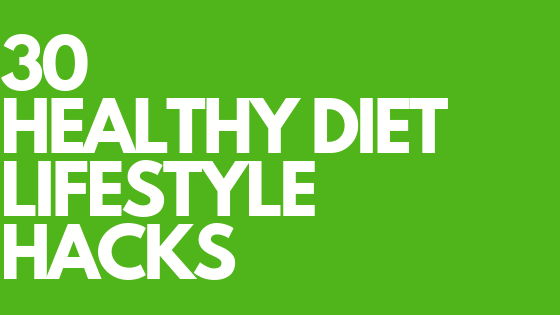You already know that common sense nutrition advice includes consuming a diet of lean protein, vegetables, fruits, and whole grains. In addition, cutting out unhealthy processed foods and items high in sugar are universally agreed to improve your health.
Read and apply these 30 additional diet lifestyle hacks to create and maintain your optimal health.
1. Create an “Eat This & Avoid This” list. This list will contain all the foods and beverages included in your diet by category and contain the list of foods you’ll chose to omit from your nutrition plan. Make this your shopping list. Read the blog post “A List of Foods to Eat & Foods to Avoid” for an example.
2. Plan out meals and snacks. Plan your daily meals and snacks each day to avoid poor choices when you get hungry. What are the times each day you get hungry, especially those afternoon snack hunger pains? Plan and prepare all your meals each day and you’ll avoid making quick bad decisions to fulfill cravings.
3. Track the food you eat. Keeping track of your food intake will help you achieve your diet and nutrition goals by eliminating the guessing game. There are a variety of apps available that make logging your meals seamless and easy.
4. Throw away junk food. Eliminate anything in your home that is not included on your nutrition plan. If it’s not there, you can’t eat it. If you wish to indulge in a snack or meal off your plan, you’ll have to go out to get it.
5. Put junk food in hard-to-find places. If you decide to keep a few unhealthy snacks in your home, make them hard to reach. It’s better not to buy the snacks, but if you buy cookies or cupcakes or treats for an occasion – if they are sitting on my counter staring you in the face, they are difficult to resist. Use the top shelves of your cabinets or very low shelves behind pots and pans. Or, put your junk food in colored containers or place them behind healthier options in the pantry. Organize your refrigerator with healthy foods up front, and less healthy foods in the back. Studies show most people consume the foods that are closest in proximity.
6. Replace desserts with fruit. Fruit is generally a much better way to satisfy your sweet tooth than traditional desserts. Fruits provide fiber and antioxidants, and they are usually available as an option when dining out, too.
7. Stock up on good snacks. Instead of junk food, you need snacks that are healthy. Keep your home and office stocked with fruits, veggies, whole-wheat crackers, nuts, lean proteins, peanut butter, etc…
8. Eat on smaller plates. Studies show that the size of your dining plates can influence how much you consume during a meal. Researchers attribute this evidence to the Delboeuf Illusion—an optical illusion of relative size perception. When serving yourself, use larger plates and bowls for healthier foods, like fruits and vegetables, and smaller plates and bowls for less healthy foods.
9. Eat off a plate instead of out of a bag. You will decrease your chances of overeating by placing your snacks on a plate as opposed to eating out of the bag. Finish your plate, not the entire bag!
10. Use a blue plate. This nutrition hack is based off a series of studies that found when a food’s color contrasted with the plate on which it was served, less calories were consumed. Experts often recommend blue because few foods are blue. In one experiment, researchers found that people ate more spaghetti and marinara sauce when it was served on a red plate, matching the sauce, than when it was served on a white plate.
11. Use cinnamon in your coffee. Rather than cream and sugar, use cinnamon to flavor your coffee. It contains fewer calories than your typical cream, and cinnamon also has numerous health benefits: It can reduce triglycerides, LDL (i.e., bad) cholesterol, and blood sugar levels. It also contains antioxidants to boost the immune system and may even improve brain function.
12. Use unsweetened almond milk in your coffee. Calories in creamers and whole milks add up. Unsweetened almond milk contains half the calories of skim milk.
13. Drink green tea. A study from the American Journal of Clinical Nutrition found that drinking green tea helps you burn more calories throughout the day while increasing fat burn. In 2008, British researchers also found that green tea improves insulin sensitivity and glucose tolerance, which helps your body send nutrients to muscle, not fat. The light amount of caffeine in green tea also promotes extra fat loss.
14. Take fish oil. Researchers found that 6 grams a day of fish oil for just three weeks led to an extra two pounds of pure fat loss. In 2007, Australian researchers also discovered that combining aerobic exercise with fish oil capsules led to more fat loss and cholesterol improvement than aerobic exercise alone.
15. Replace white carbs with whole-grain carbs. Whole grains are minimally processed and thus more nutritious than refined grains. Replacing refined grains in favor of whole grains has been linked to various health benefits, such as a lower risk of chronic diseases like heart disease, type 2 diabetes, cancers and more.
16. Avoid processed foods. Quick microwavable meals are usually high in calories, high in fat, and very low in nutrition. Packaged foods are regularly filled with artificial food coloring, flavors, additives, and fillers that can leave you bloated, inflamed, and with low energy. Start following the idea of eating real food, mostly lean proteins, fruits, and vegetables. Real food often doesn’t have a label because there is nothing added to it. An apple is an apple.
17. Eat before you shop at the grocery store. Never go to the grocery store hungry. You’re more likely to choose healthy foods if you roam the aisles with a full stomach. You will likely spend less money on groceries, too.
18. Shop the perimeter of the grocery store. The perimeter of the store is where fresh foods like fruits, vegetables, dairy, meat, and fish are located. Next hit the frozen foods – things like frozen vegetables and fruits can last longer and are cost effective. Save the center isles for last (or not at all) – that is where the processed foods are located.
19. Choose fresh or frozen over canned. Vegetables, soups, and beans in cans contain extremely high levels of sodium. In addition, canned fruits are often full of excess sugar — eliminating most health benefits. Frozen fruits and vegetables maintain more of their nutritional value.
20. Start your day with water. Drink at least 12-16 ounces of water before you drink your coffee, tea or eat breakfast. This will help to flush out toxins, activate your digestive system, kick start your hydration levels, and it’s a more effective way to wake you up than coffee.
21. Drink water before each meal. Drinking water (at least 16oz) will take up space in your stomach and cause it to expand, which sends a signal to your brain to help you avoid overeating. Maintaining hydration also supports performance, promotes recovery, and boosts metabolism.
22. Eat food high in water content to make you feel fuller faster. If you start a meal by eating foods that have a high water content, it helps to promote fullness. It also helps to slow down the digestive process and you’ll be less likely to overeat. Beans, legumes, vegetables, and fruits are just some of the foods that are high in water content.
23. Choose water over soda. Many beverages contain added sugars, dyes, and flavorings your body doesn’t need. Beverages sweetened with sugar alternatives (“zero calories”) are also increasingly linked to weight gain. Quitting soda is one of the simplest ways to improve nutrition. Quit diet sodas too. Sodas contribute to a host of health problems, including risk for obesity and diabetes.
24. Stay hydrated. Drinking plenty of water has a surprising amount of scientifically proven benefits. It promotes weight loss by lowering your total energy intake and improving metabolism.
25. Instead of sharing an appetizer and ordering your own meal, order your own appetizers and split an entree. When you share apps, you’re more likely to agree to ordering unhealthy choices. Plus, appetizers are usually more appropriately portioned for one individual rather than some of the extremely large entrees on restaurant menus. As a result, you’ll save calories by eating less food overall.
26. Order vinaigrette instead of salad dressing. This simple move often saves you calories and fat. Also, order it on the side.
27. Cook once, eat twice. Develop the habit of preparing extra protein, vegetables, and healthy sides while you’re cooking with the intention of storing for consumption later in the week.
28. Use zip bags. Prepare single servings of healthy snacks like almonds, edamame, and whole-grain crackers into zippered snack bags. When you’re packing your lunch or need a mid-afternoon snack, you’ll have exactly the right amount prepared in advance.
29. Brown bag it. Make a healthy lunch at home to take to work instead of eating at a restaurant or picking up fast food.
30. Turn off the TV and turn off your computer when eating. Watching TV (and movies or TV shows on your computer) while eating is associated with overeating and poorer food choices.
Live The Pursuit of Growth





